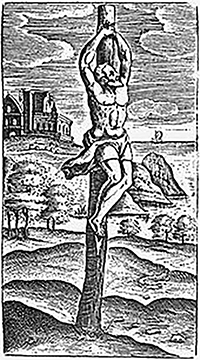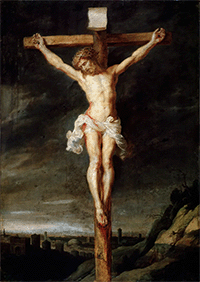

Crux Simplex was a single upright stake or post upon which the victim was tied or impaled. It was the simplest, most primitive cross used for capital punishment of criminals, traitors or enemy soldiers. The victim's hands and feet were bound and nailed to the stake using just one nail through both wrists and one nail through both ankles, and on occasion, a wooden plank was fastened to the stake as a footrest.
The Assyrians may have been the originators of this execution method, but it was quickly adopted by the Persians when they swept across Mesopotamia as conquerors. Victims of this form of crucifixion did not usually last long as it is very difficult for the lungs to exchange air when the condemned person is hanging from both arms directly above his head. If the tormentors wished to hasten the end, the victim's legs would be broken, hurrying death by asphyxiation.
Some late-19th century scholars maintained that it was this simple stake on which Christ was crucified. On the other hand David W Chapman argues that to take one single Greek word and conclude that it has one universal and unchanging meaning like the word stauros "is a common word study fallacy in some populist literature. In fact, such terminology often referred in antiquity to cross-shaped crucifixion devices. For example, Lucian, in a brief dialogue that employs most Greek crucifixion vocabulary, refers to the crucifixion of Prometheus, whose arms are pinned while stretched from one rock to another. Such a cross-shaped crucifixion position in the Roman era may actually have been the norm."

Crux Commissa
Crux Commissa was a capital T-shaped structure, also known as St. Anthony's cross or the "Tau Cross," (for the Greek letter "Tau" that it resembles). The horizontal beam of the Crux Commissa or "connected cross" was connected at the top of the vertical stake after the executioners had lifted the bar and attached victim up to the top of the post.
As it is most unlikely that Jesus, (with the help of Simon of Cyrene) carried a post large enough for use as a crux simplex to the site of execution, it is more reasonable to conclude that it was instead a cross-beam (patibulum) that was carried, and that this was subsequently attached to the stake that already stood at Golgotha.

Crux Decussata
Crux Decussata was an X-shaped cross, also called St. Andrew's cross. The Crux Decussata was named after the Roman "decussis," or Roman numeral ten. It is believed that the Apostle Andrew was crucified on an X-shaped cross at his own request.
The association with Saint Andrew develops in the late medieval period. The tradition according to which this saint was crucified on a decussate cross is not found in early hagiography. Depictions of Saint Andrew being crucified in this manner first appear in the 10th century, but do not become standard before the 17th century.

Crux Immissa
Crux Immissa, (or Latin Cross) has the familiar lower case "t" shape. This is the shape that most ascribe to the structure upon which the Lord, Jesus Christ was crucified according to Scripture and tradition. Immissa means "inserted." This cross had a vertical stake (stipes) with a horizontal cross beam (called a patibulum) inserted across a large groove chiseled into the upper portion of the stipes. The Crux Immissa has become the most widely recognized symbol of Christianity today and a Latin cross plan is a floor plan found in many Christian churches and cathedrals.
Other Features
Crosses sometimes had a platform (known as a "suppedaneum") attached to the vertical stipes, and to which the victim's feet would be nailed. This structure made it easier for the victim to use his legs to raise himself to breathe and releave pressure on his hands and arms. Perhaps more commonly used, however, was a different platform called a "sedile," (a.k.a."sedecula"). This was affixed to the stipes at a higher level and was meant to provide support to the buttocks or perineum of the victim. Writings by Seneca the Younger state that some crosses had sharp horns on the stipes that were forced upwards through the victim's genitals.
Early Christian apologists Irenaeus and Tertullian both say that there was a sedile on the cross for Jesus’s crucifixion, although that detail is not mentioned in the Gospel accounts. Both the Puteoli and Palatine graffitos appear to include a sedile in their depictions of crosses.
Both of these types of platforms helped to keep the victim from hanging completely by his arms, and therefore served to prolong the punishment and prevent early death from shoulder dislocation and asphyxia.
Scripture does not provide us insight into the detailed nature of the cross used in the execution of Jesus. This need be of little concern, of course, since our thoughts must be about the untold suffering he endured for our salvation, rather than the exact structure the cross.